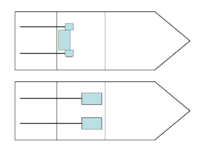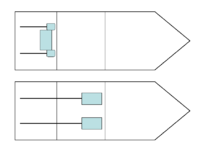TrawlerArrangement
TrawlerArrangement
Summary
Placing the engine room aft will maximize accommodation space and comfort but increase your build costs substantially if you have to use an indirect drive. The least expensive indirect option is a V-drive, followed by electric and hydraulic. Putting the galley above or below deck is a lifestyle decision. Similarly the number of berths reflects the intended use of your trawler. A master cabin and a guest cabin are the minimum configuration. Heads are like bath-rooms in a house, the more the merrier, but watch the water consumption.
Design Considerations in a Small Trawler
Deciding the arrangement of a boat can be very vexatious. It is closely allied with lifestyle. Will the boat be used by a couple, a family, weekend stag parties or just yourself? In a 50-60-ft boat the arrangement boils down to just a few key questions.
The main considerations in deciding the arrangement are:
- Pilothouse
- Widebody or side decks
- Engine room location
- Galley up or down
- Number and location of berths
- Number and location of heads
Pilothouse
The pilothouse can be fore, raised or not, or aft.
In a smaller trawler a three-deck arrangement is the norm: below decks, main deck and then a boat deck with or without an inline flying bridge. The standard configuration is a forward pilothouse with a Portuguese bridge. In this arrangement, the pilothouse is inline with the salon, sometimes with a step down. The pilothouse and salon share the main deck, usually with a cockpit aft.
If the pilothouse is raised, the salon can be arranged with a small step on a line with the forward accommodation. This one-level living is generally more comfortable. The shorter steps are better for ageing knees, too. The disadvantages are increased cost and height and the need for a deeper keel if you plan to go blue water. The increased height will limit inland cruising under bridges while the deeper keel will limit inland and coastal cruising.
An aft pilothouse is raised by definition. It places the boat deck forward, where the dinghy may be exposed to more seas. In general, an aft pilothouse is more suited to a boat that is 75 ft or larger.
Standard practice is to have a forward-slanting windshield to eliminate reflectance. This requires especial attention to wipers and washing systems, as with poor design the wipers can fall forward off the glass.
Widebody or Side Decks
On the main deck traditional designs have full side decks, allowing you to walk around the boat. An alternative design is the widebody. In the widebody, the width of the salon is extended to the sides of the boat. Often there are steps up to the top deck from the side deck alongside the pilothouse. A variation is the staggered widebody, which has one side deck usually on the starboard side.
The singular advantage of a widebody is that it increases living space. The smaller the boat, the more important this may be. Two extra feet will often make the difference between feeling like you’re in a trailer house and being comfortable. A secondary advantage is that it increases security somewhat, by restricting areas that can be accessed by boarders.
There are several disadvantages. Boarding may only be possible aft at the cockpit. Docking is more difficult. You will need cleats on the top deck for fenders. To get from the bow to the cockpit you will have to run through the salon or up to the top deck and down. This may be especially troublesome going through a lock that has vertical ropes for tie-ups that need constant re-adjustment. Lifesaving will only be possible from the cockpit or the top deck. Washing the salon windows will be more difficult, and they will lack shading from the sun. This will increase air conditioning costs.
This decision is largely a lifestyle choice. If your boat will be used mainly as a live aboard, a widebody makes sense. If you plan blue-water expeditions, side decks are safer. You will be able to conduct any kind of operation from either side of the boat. Although one side deck appears to be a neat compromise, it won’t help recoveries at sea in a storm if the action is on the wrong side.
If your boat will be less than 45 ft or used primarily inland or as a live aboard, consider a widebody or one side deck for the extra living space it affords. Over 50 ft or for extensive coastal or blue water expeditions, consider two side decks.
Engine Room
The location of the engine room decides whether or not the accommodation will be split in two. In turn, the location is dependent on the type of propulsion system, and its attendant cost. With a standard mechanical propulsion system, the engine room has to be amidships to align the engine with the shaft at a reasonable angle. Typically the master cabin is aft and several berths are forward.
This arrangement of two separate living quarters has advantages for privacy. But the space allocated to mechanical systems always seems disproportionate. And amidships just happens to be the most comfortable location for a cabin. Also, engine-room bulkheads transfer heat to the accommodation.
An amidships engine room adversely impacts air-conditioning more than an aft engine room, since there are twice as many bulkheads to transfer heat (and noise). It also complicates heating and air conditioning; and increases the general noise level aboard. Contrarily, putting the mass of the engine amidships helps the centre of gravity. However, overall the optimum layout has the engine room aft.
There are several ways of reducing the impact of the engine room on the arrangement, but they all add cost and complexity. The space occupied by a central engine room can be minimised by using a sideways engine lay-out and hydraulic or electric drives.
With hydraulic or electrical drive, the engine can be bedded in any convenient spot. It doesn’t have to be inline with the prop shaft. This enlarges the space for the accommodation, and allows more variety in layouts.
The trade-off is that the drive system is more expensive, and the larger accommodation increases the fitting out cost. So the trawler is substantially more expensive to build. Repair expertise is harder to find for hydraulic and electric drives; although construction and farming use hydraulic extensively.
With an electric drive, build costs can be contained somewhat by using only one engine. If the engine fails, an electric drive can use a house bank with suitable capacity for full emergency power.
Even more space can be reclaimed by placing the engine room aft, and making it smaller, using a mechanical V-drive, hydraulic Z-drive or electrical drive. Rotatable Z-drives eliminate any need for a stern thruster. All of the below deck accommodation will then be forward, substantially simplifying the layout of electrical wiring, plumbing, heating, ventilation and air-conditioning.
The main trade-off is in the position of the galley, especially if it has cold-plate refrigeration. A cold-plate refrigerator should be as close as possible to the engine room.
Galley
The location of the galley – up or down – is a lifestyle choice. After the location of the engine room, this decision will have the largest impact on the use of your trawler. Sexism Alert! The current trend is galley up, in the salon, supposedly to keep women happier. It’s also easier to reach from the pilothouse, when you want a quick snack or coffee. This is a bit like entertaining in your kitchen, or having a bar kitchen in your living room. Many small condo apartments are arranged this way.
Putting the galley and dinette below decks maximises space for lounging in the salon, while reducing the space for cabins. A galley below decks will have small port lights, while a galley above will have lots of light from windows and be adjacent to the entertainment centre.
Either way, there are equally good reasons. You decide on the flexibility that suits your lifestyle.
If you plan to live alone you might prefer a larger salon with the galley down. A larger salon is more conducive to entertaining on weekends, or having staff outings from your work. For a couple, there would be a downside if one person really liked to cook, because this would isolate the chef.
With a galley down, you might also consider putting a wet bar and coffee nook in the salon for convenience.
Whether the galley is up or down, don’t forget to consider its proximity to sources of fuel, electricity and water, and the type of refrigerator, in particular a cold plate vs. constant-cycle system. Shorter runs for connections are always better. A cold-plate unit needs compressor lines to and from the engine room.
Berths
The number of berths is even harder to decide; although it comes down to two options and three questions. The options are: two cabins or several. The questions are: Do you want a home for two people and an occasional guest? Do you have children? Do you want to cater to large groups?
If you want a home for two and occasional guests (i.e., one or two friends or a couple) then you need either two staterooms or a stateroom and a cabin with two berths. The rest of the space can be used for an office, library, workshop or whatever tickles your fancy. That’s the two-cabin option.
If you have children, then you must plan the cabin arrangement to suit. Ideally, each child should have its own cabin. On the other hand, if you’re single and want to have a blast with the boys and girls every weekend, then you need as many berths as you can manage (and enough safety equipment to go around). That’s the several-cabin option.
Even if you want flexibility in the number of passengers at any time, you don't want to waste space on empty berths. In addition to the owners’ stateroom, some options for additional berths are:
- Port cabin
- Starboard cabin
- Pilot berth or pilot cabin on a larger boat
- Settee berths in salon
- Settee berth in dinette
Forward cabins can be a big issue. One might be required for a couple, or perhaps two singles. So it should have a wide lower berth and an upper bunk. The upper bunk could fold-down to convert the lower berth into a settee.
Another cabin could be an office (or what have you). But it is more likely you would use the pilothouse as an office. Surrounded by large windows it would be a cheerier place to work. Alternatively, with a portable computer device and wireless (wifi) network, you could work in the salon or dinette, or the aft cockpit on a nice day.
Another arrangement would be to combine the forward cabins into a roomier stateroom for a second couple.
Heads
Heads also have lifestyle considerations. On a smaller trawler, where space is at a premium, you might have one or two heads with showers. On a trawler with an engine room amidships, you would want a head ensuite with the aft master stateroom, and another head forward in the main accommodation. If size and layout permits, a day head above decks is handy, especially if you are entertaining a gang.

